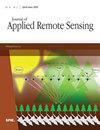利用可解释人工智能为基于机器学习的高光谱图像分类优化波段选择
IF 1.4
4区 地球科学
Q4 ENVIRONMENTAL SCIENCES
引用次数: 0
摘要
利用机器学习(ML)算法对复杂的大型高光谱图像(HSI)进行分类是一个重要的研究领域。最近,有助于解释和诠释黑盒子 ML 算法的可解释人工智能(XAI)开始流行起来。我们的研究旨在广泛介绍 XAI 方法在解释恒星仪分类中频段效应方面的应用研究,以及通过特征选择减少恒星仪的高频段数对分类器性能的影响。通过深度强化学习和 XAI 方法(如 Shapley 加法解释 (SHAP) 和 permutation 特征重要性 (PFI)),研究了对不同 ML 分类器的决策有效的频谱带的重要性水平。我们的工作使用 SHAP 和 PFI 作为 XAI 分析技术来选择具有代表性的频带。我们使用随机森林、轻梯度提升机和极端梯度提升分类器算法,在三个公开的人机交互数据集上评估了基于 XAI 的频带选择性能。应用 XAI 和深度学习方法获得的结果被用于选择频谱带。此外,我们还对研究中使用的数据集进行了主成分分析,这是一种常见的降维技术。可比较的性能评估结果表明,基于 XAI 的方法选择了信息量大的频段,在后续任务中的表现优于其他方法。因此,光谱波段的全局效应和基于类别的效应是可以解释的,而且可以通过消除对分类有负面影响的特征来提高分类器的性能。在人的生命指数分类中,使用 XAI 技术检查 ML 分类器决策的研究非常有限。我们的研究是在 HSI 分类中使用 XAI 的先驱研究之一。本文章由计算机程序翻译,如有差异,请以英文原文为准。
Optimal band selection using explainable artificial intelligence for machine learning-based hyperspectral image classification
Classification of complex and large hyperspectral images (HSIs) with machine learning (ML) algorithms is an important research area. Recently, explainable artificial intelligence (XAI), which helps to explain and interpret black-box ML algorithms, has become popular. Our study aims to present extensive research on the use of XAI methods in explaining the band effect in HSI classification and the impact of reducing the high band number of HSIs by feature selection on the performance of the classifiers. The importance levels of the spectral bands that are effective in the decisions of the different ML classifiers were examined with the deep reinforcement learning and XAI methods, such as Shapley additive explanations (SHAP) and permutation feature importance (PFI). Our work selects representative bands using SHAP and PFI as XAI analysis techniques. We evaluated the XAI-based band selection performance on three publicly available HSI datasets using random forest, light gradient-boosting machine, and extreme gradient boosting classifier algorithms. The results obtained by applying XAI and deep learning methods were used to select spectral bands. Additionally, principal component analysis, a common dimension reduction technique, was performed on the dataset used in our study. Comparable performance evaluation shows that XAI-based methods choose informative bands and outperform other methods in the subsequent tasks. Thus the global and class-based effects of spectral bands can be explained, and the performance of classifiers can be improved by eliminating features that have a negative impact on classification. In HSI classification, studies examining the decisions of ML classifiers using XAI techniques are limited. Our study is one of the pioneer studies in the usage of XAI in HSI classification.
求助全文
通过发布文献求助,成功后即可免费获取论文全文。
去求助
来源期刊

Journal of Applied Remote Sensing
环境科学-成像科学与照相技术
CiteScore
3.40
自引率
11.80%
发文量
194
审稿时长
3 months
期刊介绍:
The Journal of Applied Remote Sensing is a peer-reviewed journal that optimizes the communication of concepts, information, and progress among the remote sensing community.
 求助内容:
求助内容: 应助结果提醒方式:
应助结果提醒方式:


